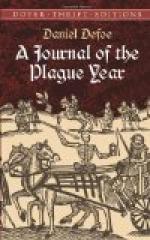Of the two hundred and fifty odd books and pamphlets written by Defoe, it may fairly be said that only two—“Robinson Crusoe” and the “History of the Plague in London”—are read by any but the special students of eighteenth-century literature. The latter will be discussed in another part of this Introduction. Of the former it may be asserted, that it arose naturally out of the circumstances of Defoe’s trade as a journalist. So long as the papers would take his articles, nobody of distinction could die without Defoe’s rushing out with a biography of him. In these biographies, when facts were scanty, Defoe supplied them from his imagination, attributing to his hero such sentiments as he thought the average Londoner could understand, and describing his appearance with that minute fidelity of which only an eyewitness is supposed to be capable. Long practice in this kind of composition made Defoe an adept in the art of “lying like truth.” When, therefore, the actual and extraordinary adventures of Alexander Selkirk came under his notice, nothing was more natural and more profitable for Defoe than to seize upon this material, and work it up, just as he worked up the lives of Jack Sheppard the highwayman, and of Avery the king of the pirates. It is interesting to notice also that the date of publication of “Robinson Crusoe” (1719) corresponds with a time at which Defoe was playing the desperate and dangerous game of a political spy. A single false move might bring him a stab in the dark, or might land him in the hulks for transportation to some tropical island, where he might have abundant need for the exercise of those mental resources that interest us so much in Crusoe. The secret of Defoe’s life at this time was known only to himself and to the minister that paid him. He was almost as much alone in London as was Crusoe on his desert island.
The success which Defoe scored in “Robinson Crusoe” he never repeated. His entire lack of artistic conscience is shown by his adding a dull second part to “Robinson Crusoe,” and a duller series of serious reflections such as might have passed through Crusoe’s mind during his island captivity. Of even the best of Defoe’s other novels,—“Moll Flanders,” “Roxana,” “Captain Singleton,”—the writer must confess that his judgment coincides with that of Mr. Leslie Stephen, who finds two thirds of them “deadly dull,” and the treatment such as “cannot raise [the story] above a very moderate level."[3]
The closing scenes of Defoe’s life were not cheerful. He appears to have lost most of the fortune he acquired from his numerous writings and scarcely less numerous speculations. For the two years immediately preceding his death, he lived in concealment away from his home, though why he fled, and from what danger, is not definitely known. He died in a lodging in Ropemaker’s Alley, Moorfields, on April 26, 1731.
The only description we have of Defoe’s personal appearance is an advertisement published in 1703, when he was in hiding to avoid arrest for his “Shortest Way with the Dissenters:”—




